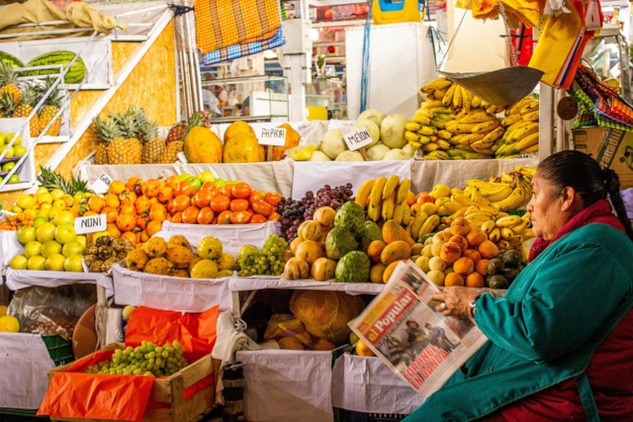
Image by Xavier Vega
In This Article:
- How shamanism uses plants to facilitate healing and consciousness shifts.
- The relationship between neurotransmitters and plant-based spiritual practices.
- How shamanic traditions can guide us in understanding the healing power of plants.
- The physiological and spiritual effects of key plant medicines.
- Can mindful living and eating enhance our spiritual and physical well-being?
The Shamanic Explanation: Dopamine, Adrenaline, Serotonin, and DMT
by Matthew Wood.
Shamanism has long been associated with the use of plants for healing and as agents for shifts in consciousness. As a herbalist, my knowledge is constellated around plants—not because I have taken lots of hallucinogens, but because plants have communicated with me through a variety of channels. This includes the doctrine of signatures—the shape, color, growth habit, or environmental niche of a plant resembles the disease, organ, or energy pattern for which the plant is remedial. It also includes empathic links through which the plants communicate their properties in pictures, words, and feelings.
The tastes and smells of plant medicines have induced physiological and psychological experiences from which herbalists learn. I have a lifetime of clinical experiences that has enriched my inner life—thank you, clients, for trusting me and teaching me over the years. Finally, I never lost the opportunity to learn from my own sicknesses. I went out intentionally to get coronavirus, taking ten flights in March 2020.
If we want, we can describe the shamanic experience in terms of the pharmacology of plants. This is not my first choice. I had no insight about this until the late, great herbalist John Redden of Toronto, Ontario explained neurotransmitters in terms of the three selves.
John was a jolly Santa Claus–like guy with a razor-sharp mind like a Jesuit. He had a good grounding in science and pharmacology, but he also had a Jesuit education, so he introduced the classical tripartite model of the soul as defined by Plato. This divides the human psyche into Reason (mentation), Desire (appetite), and Will (action, self-control, lack of control). These are reflections in the soul of the three selves. (As explained earlier in this book these are: The Humn or Conscious Self, The Animal Self, and the Spirit Self). Desire is a reflection of the animal self and Reason of the human self. The spirit is the source of the power to do—Will.
Dopamine
John pointed out that dopamine is the compound that is in charge of pleasure, reward, and pain avoidance. When it is in balance, we can experience pleasure in life, but when there is not enough we feel like “life has not given us enough.” We feel emptiness and grief.
Too much leads to hallucinations that are characteristic: the person often sees specters of the dead or hears voices. It opens us to the voices and land of the dead. These are not the voices of the spirits and totems in the Spirit World, but the remnants of living souls being processed in the Underworld through pleasure, reward, and pain-avoidance. These are the activities that “train” the animal self. Dopamine is, therefore, the neurotransmitter of the animal self.
Herbal remedies for lack of enjoyment of the body and pleasure include Wormwood (Artemisia absinthium), Mugwort (Artemisia vulgaris), and Damiana (Turnera aphrodiasia).
Adrenaline, Noradrenaline
The second major neurotransmitter is epinephrine (adrenaline), along with its sister, norepinephrine (noradrenaline); they serve to increase alertness, focus, vigilance, and consciousness. They keep us “paying attention” during the day.
Too much norepinephrine leads to nervousness, anxiety, hyperconsciousness, and obsessive-compulsive disorder (OCD), while too little leads to restless mind, attention-deficient disorder (ADD), and hyperactivity. Good remedies for OCD include Passionflower (Passiflora incarnata) and Horse Chestnut (Aesculus hippocastanum). Hawthorn (Crataegus spp.) and Schizandra (Schizandra chinensis) are good remedies for ADD. Lemon Balm (Melissa officinalis) is good for nervousness similar to ADD.
If we run into a threat, adrenaline is poured out and we switch from ordinary alertness and awareness to “fight or flight.” The blood rushes from the guts to the brain and limbs so that we can respond intelligently and forcefully by making the decision to run away or stand and fight. Unfortunately, our system has not developed to the point where we are able to differentiate between an actual threat (rattlesnake in the kitchen) and a perceived threat (work deadlines). Or even a picture in our mind of a threat. Therefore, we treat both actual and perceived threats in the same way.
In this state, the sympathetic nervous system is overstimulated while the parasympathetic (rest, relax, rebuild) is suppressed. This leads to a state of anxiety, nervousness, and excitability, with exhaustion and inability to rebuild. This is called “adrenal fatigue” in folk medicine; a condition not understood in conventional biomedicine.
We can never run out of adrenaline, so that is not the deficiency. It is the fact that adrenaline suppresses the digestion and that makes impossible the digestion and assimilation of fats and oils essential for the health of the adrenal cortex. This means we need a combination of nerve sedation and lipid digestion.
This condition responds to nervines for anxiety like Lemon Balm (Melissa officinalis), Motherwort (Leonorus cardiaca), or Borage (Borago officinalis), combined with lipids to rebuild the parasympathetic and the adrenal cortex. Burdock root (Arctium lappa) is excellent for rebuilding lipid mechanisms and reduces worry and anxiety.
Serotonin
The third neurotransmitter is serotonin. It operates differently at different levels. A modest deficiency causes rumination, negative self-dialogue, and melancholy; the person is stuck in their inner self, unable to solve problems or connect with the world. This is not really “depression” per se (from actual loss, grief, setbacks, etc.), but fits the old-fashioned term “melancholy,” which is more of a creative or spiritual angst involving lack of imagination, artistic funk, and anxiety.
Herbalist Sean O’Donaghue notes that melancholia matches the crisis that the shamanic personality experiences, and that it is usually suppressed by drugs (MAO inhibitors) in conventional medicine, which artificially keep serotonin levels up without dealing with the problem. It is possible that one of the reasons our society is careening out of control is the suppression of this stage of life, which is required for psychological and spiritual problem-solving.
Serotonin in moderation helps a person to switch back and forth from the social world to the internal world, leading to a “well-adjusted” person. There is a balance between self and other. It supports the “gentle spiritual path,” whereby the soul is constantly fed a small stream of inspiration and insight from the spirit, so that the soul develops in an increasingly mature direction, without losing contact with ordinary human society.
Appropriate levels of serotonin are associated with gaining perspective on life and therefore with something that is very important: gaining impulse control. Without impulse control we cannot venture far into the shamanic world, which tests our desire, reason, and will in every conceivable way.
Serotonin also causes problems in excess. Modest excess pushes a person into an intensification of sensory input, which can be overwhelming in a social setting, so once again the person is pushed into isolation. Here there is a greater potential for creative and spiritual development, but with isolation from society. We can see that Eliade’s shamanic personality is starting to form.
It seems possible that we can have too much serotonin, leading to social isolation and introversion, conjoined with highly creative or unusual orientations. This resembles the autism spectrum. However, because self-understanding is built into introversion, high serotonin levels and neural receptor sites for serotonin can be associated with stability of character and impulse control.
Dimethyltryptamine (DMT)
Serotonin in balance (combined with reasonable decision-making) leads to a solid spiritual or meaningful life, within the social network, but it does not reach the Spirit World in the same way that dimethyltrypt-amine does. This is the “spirit molecule,” as psychiatrist Rick Strassman named it, because DMT brings on visions and all-engulfing experiences of non-ordinary reality. It also develops a more dense net of serotonin-receptor sites, leading to a more balanced presence in the social world.
The reverse may also be true: higher levels of serotonin may enhance the DMT experience. Impulse control (serotonin) can enhance positive spiritual lessons (DMT), while DMT and the spiritual lessons it provokes can enhance impulse control and the “purposeful life” associated with good serotonin levels. .
DMT is made in the brain and the brain craves any external DMT that comes along. However, it is broken down in the small intestine and does not easily get to the brain when taken orally. Shamans, drug fiends, and psychiatrists have their ways, however. Ayahuasca consists of a plant that contains DMT (Banisteriopsis caapi), with another herb that helps it pass the blood-brain barrier. When ethnobotanists asked Amazonian shamans how they figured out which plants to put together—there are over a thousand different species per hectare in the rainforest—commonly said the planets told them what to do.
It is possible to generate DMT simply through spiritual exercises. When Richard Alpert (Ram Dass), the early drug researcher-turned-spiritual-pilgrim, went to India, he gave a massive dose (of LSD) to an Indian guru. The man did not change in the least; his brain was already awash with self-manufactured DMT.
The DMT innate to a person’s own system is the only completely safe and healthy source since reliance on plant sources will tend to suppress the manufacture of native DMT, just as reliance on medical drugs to keep up serotonin levels will suppress the development of true self-regulation. Occasional use of DMT, on the other hand, might stimulate more production—or the visions that would call creativity forth. There is a long history of DMT use by shamans. Maria Sabina’s work with psilocybin, in central Mexico, is a well-documented case.
Mindful Living and Mindful Eating
Today we not only need to develop adequate serotonin levels through mindful living, but through mindful eating. This is because modern corporations play to our appetitive nature, encouraging it through the use of addictive levels of sugar, salt, unhealthy lipids, and synthetic foods.
We also develop food and substance allergies to never-eaten-before processed food, spilling histamine and heparin into our system, causing allergic reactions, sensitive tissue, and changes in local blood supply. Today, spiritual consciousness requires good, sound food, as well as spiritual desire, discipline, and effort. And everyone should exercise, whether on a spiritual path or just trying to stay healthy. “Chop wood, carry water.”
Copyright 2024. All Rights Reserved.
Adapted with permission.
Article Source:
BOOK: A Shamanic Herbal
A Shamanic Herbal: Plant Teachers and Animal Medicines
by Matthew Wood.
 Sharing profound experiences from his long career as well as his first years growing up on a remote Seminole reservation in the Everglades, renowned herbalist Matthew Wood interweaves practical herbalism and the spiritual potency of Nature to deeply explore the plant teachers, animal medicines, and foundational principles of shamanism as a spiritual path.
Sharing profound experiences from his long career as well as his first years growing up on a remote Seminole reservation in the Everglades, renowned herbalist Matthew Wood interweaves practical herbalism and the spiritual potency of Nature to deeply explore the plant teachers, animal medicines, and foundational principles of shamanism as a spiritual path.
For more info and/or to order this book, click here. Also available as a Kindle edition.
About the Author
Article Recap:
This article explores the profound relationship between shamanism, healing plants, and shifts in consciousness. It delves into how shamanic traditions use plant-based medicines to influence neurotransmitters, guiding individuals through spiritual and physical transformations. By understanding the effects of plants like DMT, serotonin, and dopamine, we gain insight into the ancient practices that support both mental and spiritual health. The article emphasizes the importance of mindful living and eating in enhancing overall well-being.



 Matthew Wood has been a practicing herbalist for more than forty years. He is an internationally known teacher and author with more than ten books to his credit, including The Book of Herbal Medicine, The Earthwise Herbal, Holistic Medicine and the Extracellular Matrix, and A Shamanic Herbal. Matthew has an MSc in herbal medicine from the Scottish School of Herbal Medicine (accredited, U. of Wales).
Matthew Wood has been a practicing herbalist for more than forty years. He is an internationally known teacher and author with more than ten books to his credit, including The Book of Herbal Medicine, The Earthwise Herbal, Holistic Medicine and the Extracellular Matrix, and A Shamanic Herbal. Matthew has an MSc in herbal medicine from the Scottish School of Herbal Medicine (accredited, U. of Wales). 


























